
 |
Reno 2013 - 50 Years of Unlimited Air Racing
Text and Photos by Dan Whitney
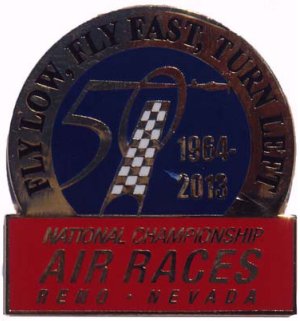 |
This year’s race marked the 50th year of Unlimited Air Racing at Reno! It was an outstanding event: Safe and exciting, with some of the best racing ever! That is not to say that there were no issues, for in fact the issues resulted in the smallest Unlimited field in memory. This was largely the result of the FAA strictly enforcing a “not to exceed” height of 250 feet, which many pilots felt was unsafe as it gave them no place to go when things get tight, and the fact that purses were reduced to the point that many teams could not afford to participate. With a full field of Gold, Silver and Bronze Unlimiteds there is room for 27 racers. This year’s field of only 14 (19 racers were entered last year) meant that there was no Medallion or Bronze class racing at all, no Unlimiteds raced on Thursday, and there was only the Silver heat on Friday. That said, there was some very good racing on Friday, Saturday and Sunday. One of the more interesting stories of the week resulted when 2012 Gold winner Strega, piloted by Matt Jackson this year, came down the “chute” for his qualifying lap on Tuesday. At about 800 feet and over 500 mph the canopy shattered, dazing Matt for a moment, but he was protected by the windscreen and his face mask and able to pull-up and safely return to the ramp. Repairing the damage required replacing the canopy and windscreen, which took two full days and meant that Strega did not “qualify” for the races. This required that Matt win Friday’s Silver heat, which would qualify him for the Saturday Gold. Starting from last place he easily passed the other racers and appeared to have won, only to be disqualified for a forced showline cut while passing another airplane. This meant that he had to win Saturday’s Silver heat in order to advance to Sunday’s Gold, and again from the last starting position. This time he was successful and took the win, advancing to the last starting position for the upcoming Breitling Gold Final. In the course of the two races fans were treated to an exciting display of Matt’s airmanship as he worked his way past the entire field of racers, twice! |
| 50th Anniversary of the races 1964 - 2013 |
The Big Picture
This year’s field had seven Mustangs, five Sea Furys and one each Bearcat and Yak. The good news was that there were some really competitive airplanes, pilots and crews racing them.
Perennial favorites Strega (P-51) and Rare Bear (F8F Bearcat) were back, but with a new pilot in Strega and a new crew for “The Bear”. They were joined by Voodoo and crew, who returned after a two year hiatus, this time piloted by four time Reno winner Steven Hinton, Jr. Steveo had decided to move on after winning in Strega the past four years and was offered the ride in Voodoo. He took it on the provision that he be allowed to also “wrench” on the airplane. Czech Mate, the R-2800 powered Yak, was also back after a three year rebuild of its wing. Rounding out a “six-pack” of highly modified racers was the Sea Fury 232, piloted by astronaut “Hoot” Gibson, and the Griffon powered P-51 Precious Metal, sporting an awesome new paint job, and completely reworked during the off-season. The balance of the field was composed of some very competitive Sea Furys and Mustangs for the Silver class.
As is usual, Monday through Wednesday noon is reserved for qualifying, with a total of five sessions available for the Unlimiteds. All went well, the only casualty being Strega’s lost canopy. Expectations were that there were going to be some very high qualifying speeds. Steve Hinton in Voodoo was hoping for the first 500+ mph qualifying lap on the current tight course. His team had prepared a special Merlin just for qualifying, which they dutifully changed following his best speed of the week effort at 491.587 mph. Steve said he left 1.5 – 2 seconds on the course due to being “rusty”. Sea Fury 232 qualified second at 479.164 mph, the fastest ever for a Sea Fury, while Rare Bear was third at 473.105 mph. See the table at the end of this article for a complete tabulation of the racers and speeds.
With the first Unlimited heat being the Friday Silver, you might expect things to be pretty quiet in the pits. While it was for some, it wasn’t for others, particularly for Rare Bear and its crew. They were fighting a carburetor mixture issue all week, as a result they were down some 45 psi in Torque Pressure, which meant that there was some 400+ horsepower missing, and it showed in their non-winning speeds. The Strega crew was hard at work installing the new canopy and windshield, Voodoo was completing the engine change and everyone else was checking every detail at least once.
The Racing Airplanes
The following discussions of each airplane tell how its week went.
#5 Voodoo, a modified P-51 similar to Strega and powered by an Allison-rodded Packard Merlin. After sitting out two years the racer was back with an augmented team and Steve Hinton Jr. as pilot. This team became the one to beat, as they had their act together and came with the intent to set a new qualifying record, as well as win the gold race on Sunday. To do this they brought two race ready Merlins, one for qualifying and the other for racing.
Things progressed as expected with Hinton going out Monday for his qualifying effort. This went well, but the hoped for speed of over 500 mph was missed as he posted 491.587 mph. Steve later said that with the route he followed around the course he thought he left 1.5 – 2 seconds on the course. If he had followed the route he used for racing the rest of the week, and picked up the two seconds, his speed would have been 508.8 mph, so the airplane was certainly capable of exceeding the hoped for 500 mph threshold.
In Saturday’s Gold Heat Hinton started from the pole and maintained a lead over the field of seven racers, but with Sea Fury 232 in pursuit. Voodoo won the six lap race with a speed of 487.323 mph. Sunday was a repeat for Voodoo, with Hinton in the lead from the beginning of the eight lap Breitling Gold final. The field of nine racers all completed the race with both Voodoo and Strega lapping the last three aircraft. Hinton won with a speed of 482.074 mph, some six seconds ahead of Strega who took second place with a speed of 474.926 mph.
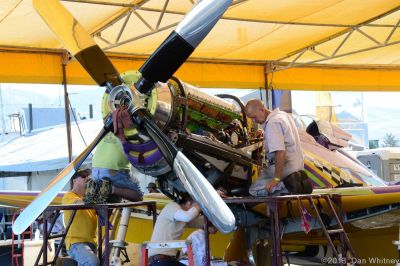 |
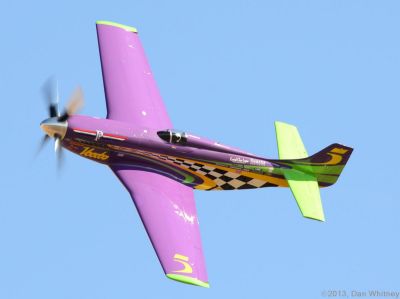 |
| Starting as soon as she cooled down from qualifying the Voodoo crew set to changing from the qualifying to racing Merlin. There were no hitches and the new engine was running on the ramp Tuesday evening. | Steve Hinton bringing Voodoo past the #2 Pylon during Sunday’s Breitling Gold final. |
#7 Strega, a highly modified P-51D Mustang with a Mike Nixon Merlin, was flown this year by Matt Jackson, who was unable to qualify due to the lost canopy. Racing from the rear of each heat Matt put on quite a display of flying, impressively passing the entire field within the first three laps in the Saturday Silver. Strega’s Merlin is the same one that has powered the racer for the past four of five years. Mike gives it an IRAN (Inspect-Repair-As-Necessary) each year and has been able to get reliability out of it better than the competitors, even when running races at 3,400 rpm and over 105 inHgA. The airplane would likely have qualified at over 490 mph (did 499+ two years ago), but only had to go 430 – 440 mph to best the Silver racers, twice! This probably actually saved the engine some in that normally Strega would be competing against the Gold racers on Friday and Saturday, and a lot more would have been demanded in those heats in order to place 1st or 2nd.
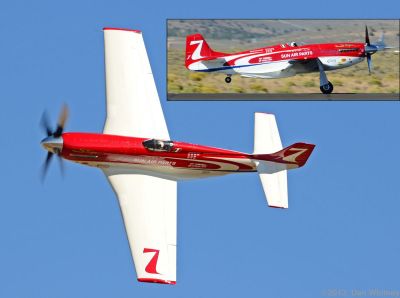 |
| Strega on the course during the Breitling Gold on the way to a 2nd place finish; note the new bow framing the windscreen. Inset shows Matt landing on Tuesday after the canopy glass blew out. |
On Sundays Breitling Gold Final Matt started from last place, as “Tail End Charlie” coming down the chute. By the end of the 3rd lap there was only one racer ahead of him, Voodoo. Steven Hinton in Voodoo never let-up from the start so he had a considerable lead on Strega, one that Matt couldn’t overcome. But there had been some really exciting action as he passed the field and positioned himself for the win if Hinton cut a pylon or had any mechanical issues. Great race!
#86 Czech Mate, a highly modified Yak 11, powered by a P&W R-2800. This mighty-mite is a very capable airplane back at Reno after a three year effort to rebuild and strengthen the wing. Pilot Sherm Smoot qualified at 464.876 mph, putting him in the select group of racers given a bye for Friday racing. In the Saturday Gold heat he kept Czech Mate in 3rd place waiting for the leaders to falter, which Hoot Gibson did in 232 on the next to last lap, thereby leaving Czech Mate to finish in 2nd place at 462.324 mph. In the Sunday Breitling Gold final Sherm was again in 3rd place most of the race, ahead of competitors such as Rare Bear and Precious Metal. At the end he finished 3rd at 455.770 mph, some five seconds ahead of The Bear.
The year ended for the hard working team when the airplane lost a brake when landing back at their home field, ending up in a ground loop and was damaged. Fortunately Smoot was not injured, but there is a lot of work to do to get Czech Mate back in the air.
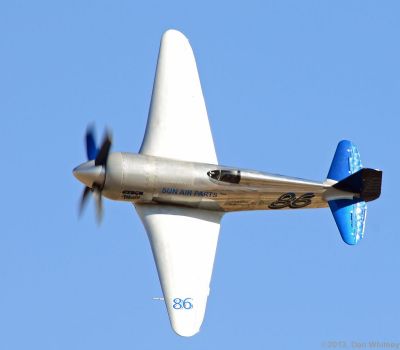 |
| Czech Mate based on a classic Yak 11, but strengthened throughout for the mighty R-2800, shown here rounding Pylon 2 during the Breitling Gold, and in place for the win if either of the two Merlin powered racers faltered. |
#77 Rod Lewis’s Rare Bear, the highly modified F8F-2 Bearcat powered by a Wright R-3350 and flown by Stu Dawson, had been sent to Nelson Ezell’s in Texas for reworking of the engine compartment. The team had decided to abandon the wing root carburetor air intakes in favor of a scoop on a revised the engine cowling. The cowling exit area for cooling air was also enlarged, which proved effective in reducing cylinder head temperatures, a major issue last year as well as making space for the individual exhaust pipes, which replaced the old siamised pipes.
Stu qualified the airplane at 473.105 mph, down from 490 mph last year, which was attributed to fuel mixture issues with the carburetor. Carburetors were The Bear’s issues this year. While the original setup had been outstanding when tested in Texas, something was wrong at Reno. Stu abandoned a qualifying attempt on Monday as he was not able to develop full power. Monday night they retimed the engine from 20° BTC to the correct 27° and Rare Bear was able to make a qualifying run Tuesday morning with 200 psi torque pressure, about 3,200 bhp, when they intended to run 245 psi. Stu qualified at 473.105 mph even though he lost a magneto and dropped 30 psi torque pressure during the run; definitely in the run for the Gold.
The missing power was due to a very rich running carburetor, 480 gph instead of the expected 380 gph at power. Also so much oil was being burned that the plugs had to be changed after every flight as they were wet and fouled. In an effort to resolve the carburetor issues last year’s carburetor was installed, but it uses a non-optimum fuel spray nozzle which resulted in mixture distribution problems, and most distressing, a tendency for the engine to cut-out when power was pulled back to land. By Thursday the replacement carburetor was found to be running the engine too lean as exhaust gas temperatures were in excess of 1,400° F, so the decision was made to switch back to the original unit.
Rare Bear ran well in both the Saturday and Sunday gold heats, finishing 3rd on Saturday and 4th on Sunday. Race speeds were extremely consistent at 451.108 and 451.352 mph respectively, and in both races The Bear finished behind the R-2800 powered Yak, Czech Mate. The speeds show that the team had elected to run at a steady reliable power and not push the engine.
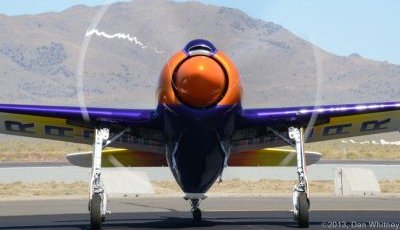 |
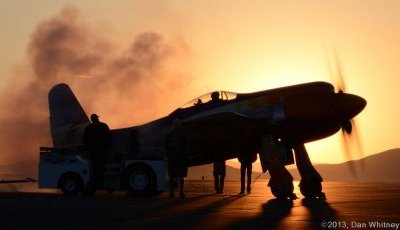 |
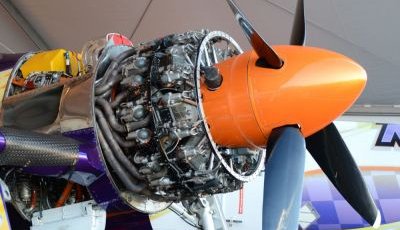 |
| Rare Bear sporting a new carburetor inlet built into the cowling. The revised cowling air outlets improved the flow of cooling air for the engine, reducing cylinder head temperatures. | With the carburetor and ignition changes Rare Bear was out at all hours doing run-ups and flight checks. Here she is early Saturday morning starting up for a check flight prior to the first Gold heat of the week. | Rare Bear engine compartment, note the complex diffuser with turning vanes to take the air down into the carburetor. This year the siamised exhaust stacks were replaced with individual pipes from each cylinder; makes for a lot of plumbing. |
#38 Precious Metal, the highly modified P-51D powered by a Rolls-Royce Griffon 57A driving a contra-rotating propeller was back with an entirely new look. Pilot/owner Thom Richard not only gave it a stunning new paint job, but a number of airframe updates and modifications as well. Noticeable was the new elongated canopy and wingtips, and not so obvious was the special racing “doghouse”, that is the coolant radiator housing. This unit was from the racer “Ridge Runner III”, which has been sold and is now operated as a stock P-51D.
Important to his plans for going fast this year was a specially prepared Griffon featuring newly designed “white metal” main bearings. During its initial runs prior to launching for Reno the bearings failed, and with time running out, the team decided to install the undamaged sections of the engine on their spare and use that engine for Reno. Looking at photos of the engine you can clearly see the original “yellow” painted parts on the stock “red” crankcase.
Precious Metal’s Griffons were originally modified for racing by the “Miss Budwiser” hydroplane team, and retain the special supercharger step-up gears they installed. During pre-race testing at Reno Richard found that the Ridgerunner radiator setup may be too small for the Griffon, meaning that he would use up the entire 96 gallons of spraybar water by lap six. Since the Breitling Gold is an eight lap race he was required to run with the radiator exit flap slightly open, which increases drag.
During qualifying Thom ran 440.385 mph, down from the 463.301 mph he qualified at last year, suggesting that he appreciated he was running on his backup engine and that after the week of racing he still had some 2,000 miles to fly back to home in Kissimmee, Florida. Even so, during Saturday’s Gold heat he stepped it up to 444.238 mph and finished 4th. On Sunday Thom intended to use the power necessary to pass Sherm Smoot in #86 Czech Mate, which would have put him in position for a 2nd or 3rd place finish. As it turned out, both Rare Bear and Czech Mate found some more speed so Richard backed off a bit, finishing in 5th position at 434.682 mph.
 |
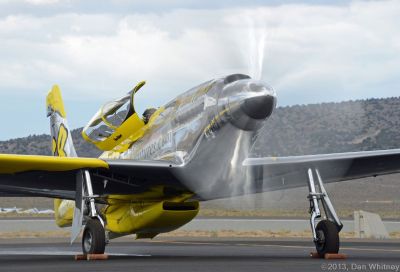 |
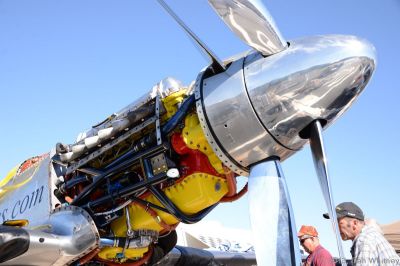 |
| The new paint job, canopy and wingtips are evident in this photo of Precious Metal rounding Pylon 2 during Sunday’s Breitling Gold final. | Richard fitted the special racing “Doghouse” from Ridge Runner III to Precious Metal for this year’s races. | Precious Metal lost the main bearings in its specially prepared Griffon race engine just a week before Reno. The crew refit the undamaged special parts, painted yellow, and installed them on their backup Griffon. Still a very creditable package, running at up to 2,850 rpm and 90 inches during the race. |
#8 Dreadnought, a modified Sea Fury T.Mk.20 powered by a Pratt & Whitney R-4360, was flown by Brian Sanders this year. This was the only R-4360 powered racer this year and she ran steadily in the pack of Gold racers. Qualifying at 447.838 mph she finished 5th on Saturday at 430.437 mph and in 6th place on Sunday at 423.700 mph. Definitely the fastest finisher of the Sea Furys.
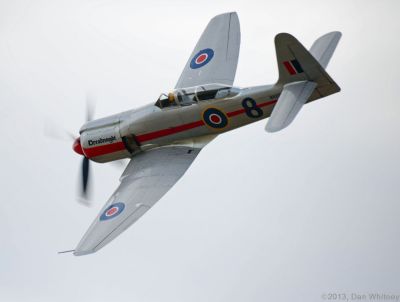 |
| Dreadnought rounding Pylon 8 during Saturday’s Gold heat race. She ran a steady pace finishing 5th at 430.437 mph after Sea Fury 232 Mayday’d on lap five. |
A fun display for the fans was an engine shown behind the Grandstands: the Pratt & Whitney 5600 XBSAP! A fifty-six cylinder radial with eight rows of seven cylinders and displacing 8,720 cubic inches! A massive R-8720 power plant. A lot of people stood around scratching their heads over this one: that is, until they realized it was two R-4360 power sections bolted together! A lot of “experts” and “aviation buffs” were heard to make some interesting rationalizations and statements of “fact” about its history!
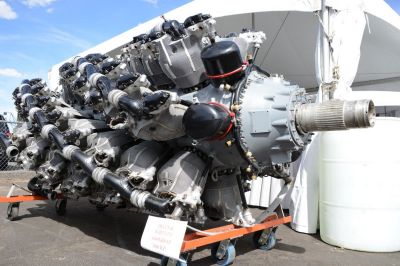 |
| This was a surprise display engine, the infamous P&W R-8720! A spoof of what a “Double Wasp Major” would look like, eight rows, each with seven cylinders. What would the racer look like? The sign says “P&W 5600 XBSAP”, a reference to there being 56 cylinders. The “XBSAP”? |
#71 Sawbones, a Wright R-3350-26WA powered Sea Fury FB.11, was again flown this year by Curt Brown. Following Strega’s disqualification for a showline cut Curt won Friday’s Silver heat with a speed of 422.460 mph, some 22 seconds ahead of the second place aircraft. Sawbones then advanced into the Gold round for the upcoming Saturday race.
In the Saturday Gold heat Sawbones finished last at 420.503 mph, ten seconds behind Dreadnaught, and was nearly lapped by the winner Voodoo. Sunday’s race was similar in that Sawbones finished 7th in the nine aircraft field while being lapped by both Voodoo and Strega. As the speed was only 407.140 mph, it was apparently clear from the back of the pack that there was no need to push when the likes of Voodoo, Strega, Czech Mate and Rare Bear were running hard up front.
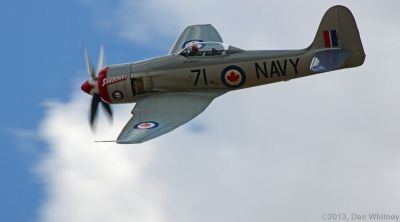 |
| Sawbones, powered by a Wright R-3350-26WA from a Skyraider, was the only Sea Fury with a win this year, in Friday’s Silver heat. This bumped the racer into the Gold heats for Saturday and Sunday. |
#11 Miss America, a modified P-51D powered by a Rick Shanholtzer V-1650 race Merlin, and flown by Brent Hisey, qualified at only 389.878 mph, but finished in second in Friday’s Silver heat with a speed of 400.143 mph. In Saturday’s Silver Hisey had the misfortune of being disqualified by the Contest Committee for flying too high on Pylons 2 and 8 during the last lap. In Sunday’s seven lap Silver final Miss America was the winner of the field of five at 398.944 mph.
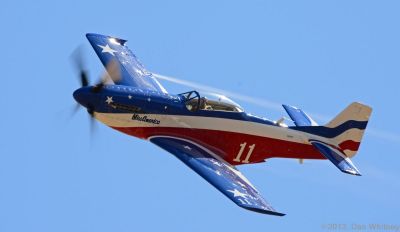 |
| Brent Hisey and Miss America during Sunday Silver, which he won. Shown here nice and low, making sure that he wasn’t again disqualified for flying too high. The contrail coming from the right wing is venting spraybar cooling water. |
#232 232, a modified Sea Fury FB.11 powered by a special Wright R-3350, and flown by former shuttle astronaut “Hoot” Gibson is a stable mate of Rare Bear, both being owned by Rod Lewis. Hoot qualified the airplane at 479.164 mph, making him the fastest ever Sea Fury qualifier and making him second overall this year. Compared to the action in the adjacent Rare Bear pit the crew of 232 had it easy. The airplane was cooperating; no big issues and they were ready for the Gold racing to start on Saturday.
Saturday’s Gold race quickly developed into a very fast parade, led by Voodoo some 7 to 10 seconds ahead of Hoot in 232, who was running a very tight and smooth course. On the next to last of the six laps in the heat, 232 was about midway down the homestretch when a huge fireball came out the left side exhaust stacks along with a couple of major backfires. Hoot immediately pulled up and backed off the power. The engine was still running and he smoothly arched around and landed safely on the back runway. Hoots’ experience in dead stick landing the Shuttle certainly paid off!
Post flight analysis of instrumentation and video showed that the carburetor intake scoop collapsed, which in turn sent shards of carbon fiber material down through the carburetor, with some of them lodging in the intake valves, hence the backfires, which were so violent that they destroyed the intake trunk and damaged the cowling and propeller spinner.
Close inspection of the engine found no burned pistons, so it is hoped that a complete teardown and overhaul will have it up and running for next year.
 |
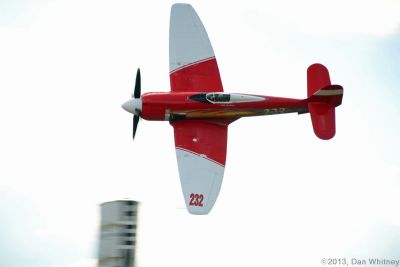 |
| #232 crew enjoying the warm sun on Saturday morning before the first Gold heat. Pilot “Hoot” Gibson is standing just behind the prop, with Crew Chief Jim “JD” Dale on his right. Painted on the gear door is the Sea Fury record 480.249 mph lap posted in qualifying, which was subsequently reduced by the Competition Committee to 479.164 mph without explanation. | Shuttle astronaut “Hoot” Gibson rounding Pylon 8 in 232 just seconds before the collapse of the induction scoop. Speed is over 480 mph, even with the tail wheel gear door open. Note in the dark exhaust stack area flames are uniformly coming from each of the exhaust stacks. All appears well at this point. |
#114 Argonaut, a Sea Fury FB.11 uniquely powered by a Pratt & Whitney R-2800, and again flown by Korey Wells. This was the third season for Argonaut with the R-2800-CB3 and it is still the only modified Sea Fury with the R-2800. Qualifying speed this year was only 382.360 mph besting five other racers.
Still Argonaut provided some of the closest racing all week when paired against its Centaurus powered stablemate #924, flown by Dennis Sanders. On both Friday and Saturday these two airplanes finished only ¼ second apart, after the six lap 48 mile race! Literally side by side for nearly 100 miles. Definitely some concentration here!
The winner of the Saturday Silver heat was Strega, who was automatically bumped up into the Gold for Sunday. As such, the second place finisher, Argonaut, was declared the winner. Korey Wells elected to also bump up into the Sunday Gold, which made for a field of nine Gold racers.
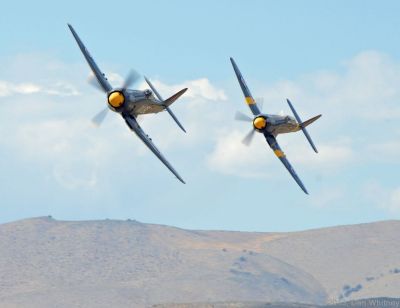 |
| The R-2800 powered Argonaut leading the Centaurus powered Sea Fury #924 at Pylon 2. These two airplanes were within ¼ second of each other for both the Friday and Saturday Silver heats, over 98 miles of close competition. Argonaut beat #924 in both outings posting speeds of 369.488 mph and 369.087 mph on Friday and Saturday respectively. |
#924 924, a Sea Fury T.Mk.20 powered by its original Bristol Centaurus engine, flown by Dennis Sanders. This airplane, now sporting a new period correct paint scheme, was qualified by Dennis at 373.111 mph, in the middle of the field of Silver racers.
With the very close racing between Dennis and Korey it happened that Dennis cut a pylon in Friday’s race and was penalized 12 seconds, so his official speed for the race is listed as 360.013 mph when in fact he was ¼ second behind Argonaut, who posted 369.488 mph. On Saturday this speed was good enough to finish 3rd, and then in the Sunday Silver heat Dennis finished 2nd at 388.923 mph, just behind Miss America. When Brent Hisey elected to bump up into the Gold, Dennis and became the Silver winner. These racers were having a lot of fun and clearly wanted a place in the coveted Breitling Gold.
 |
| Sea Fury Mk. 20 #924 with its new Royal Navy paint job and the left-hand turning 18-cylinder Centauraus with 5-bladed Rotol in close pursuit of its stablemate Argonaut. |
#44 Sparky, a stock Merlin powered P-51D flown by Brant Seghetti. Brant qualified this year at 361.875 mph, up from 353.822 mph last year. During the Friday Silver heat race he posted 315.735 mph, putting him in last place but ahead of two airplanes that were disqualified for showline cuts. On Saturday he stepped it up to 321.158 mph and finished just ahead of Doug Matthews in The Rebel, another stock Mustang. On Sunday these two had another good race, with Brant finishing less than a half second behind The Rebel and posting 335.715 mph.
#12 The Rebel, another stock Merlin powered P-51D flown by Doug Matthews. Following some close racing with Sparky, Doug was able to pass and finish in front on Friday at 333.690 mph. On Saturday they again raced hard with Sparky having the advantage at the end. Sunday these guys pushed it up a notch, with Doug finishing ahead of Sparky, 336.017 mph to 335.715 mph, less than half a second difference over the six laps they ran.
 |
| These two stock P-51Ds gave the fans some exciting and close racing. At this point in the Friday Silver heat Sparky is leading The Rebel, but they actually finished the race with The Rebel ahead of Sparky. |
#47 Ole Yeller, a stock Merlin powered P-51D Mustang raced by John Bagley. This is the original Bob Hoover P-51 and retains his classic color scheme. John qualified the airplane at 365.791 mph. Flying in Friday’s Silver heat he was disqualified for a showline cut, but came back on Saturday to post a 4th place finish at 355.282 mph. In Sunday’s Silver he finished ahead of the other two stock Mustangs with a speed of 350.950 mph, placing 2nd after Brent Hisey in Miss America elected to bump up into the afternoon’s Gold heat.
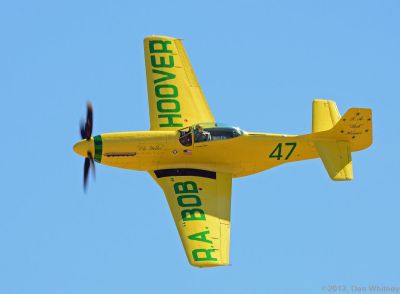 |
| John Bagley now owns Bob Hoover’s classic P-51D Mustang Ole Yeller, and although he has completely restored the aircraft, he retained Bob’s paint scheme. Beautiful aircraft and raced really well. |
Summary
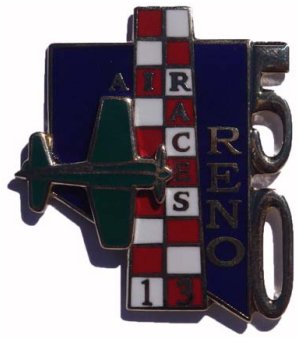 |
The 50th year of Reno Air Racing is now in the books. It was a good year for the competing pilots and Unlimited racers. The reduced field was a disappointment, but the quality of the racing, the race planes and their engines was outstanding. It is hoped that the sponsoring entity RARA, Reno Air Racing Association, will be successful in getting the FAA to adopt a more reasonable altitude limit, while they revisit the size of the purses for competitors. These two changes would go a long way toward attracting more racers. Even so, the race fans in attendance saw what they came for and thoroughly enjoyed the event. See you at Reno 2014! |
| 2013 Reno Air Races Hat Pin denoting the 50th Anniversary of the races |
 |